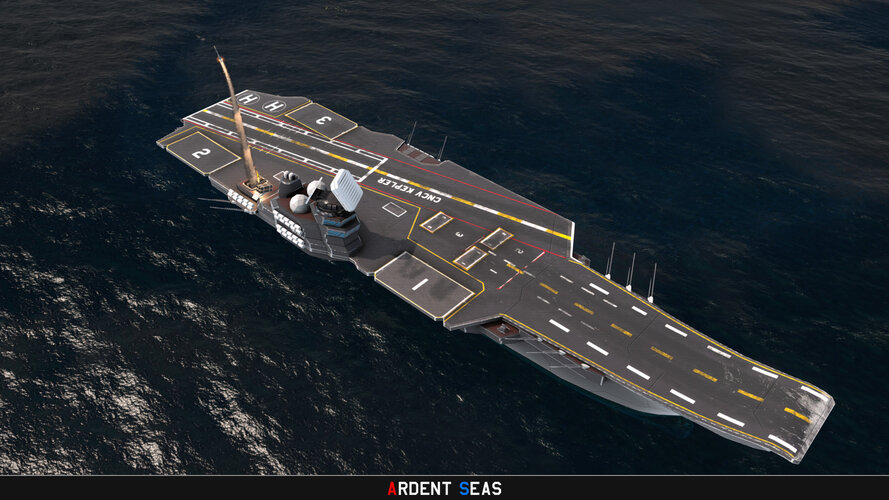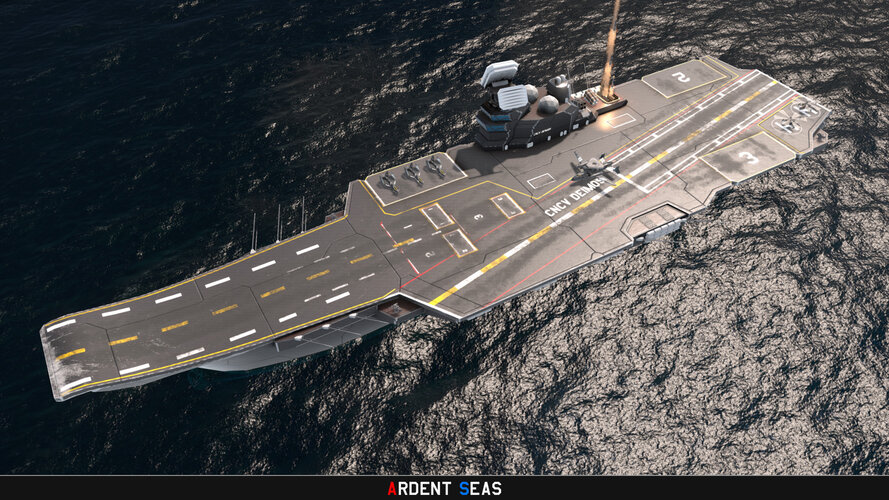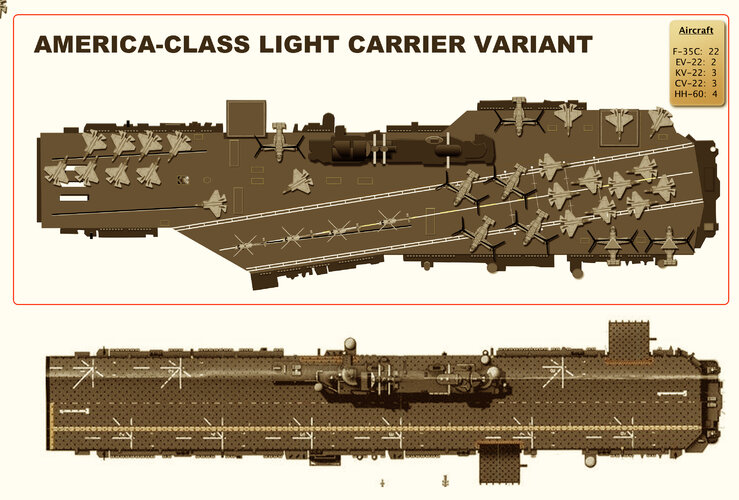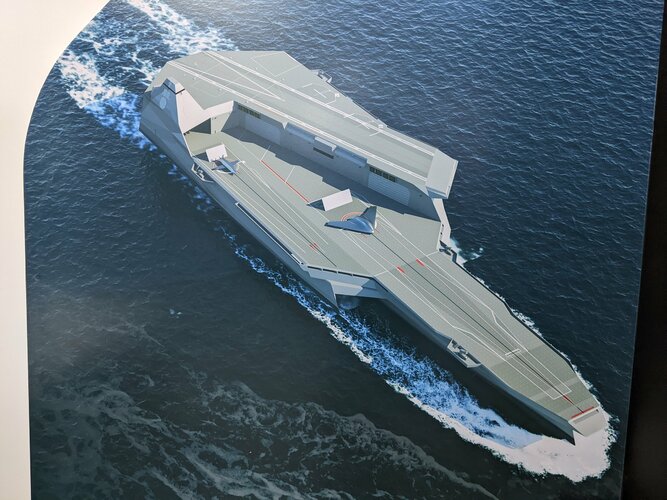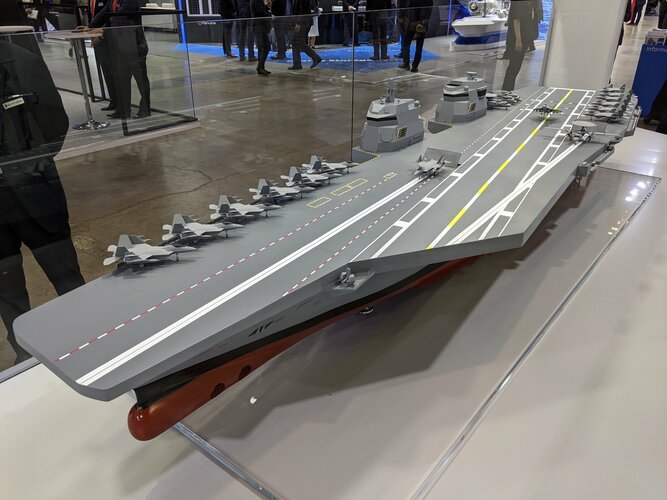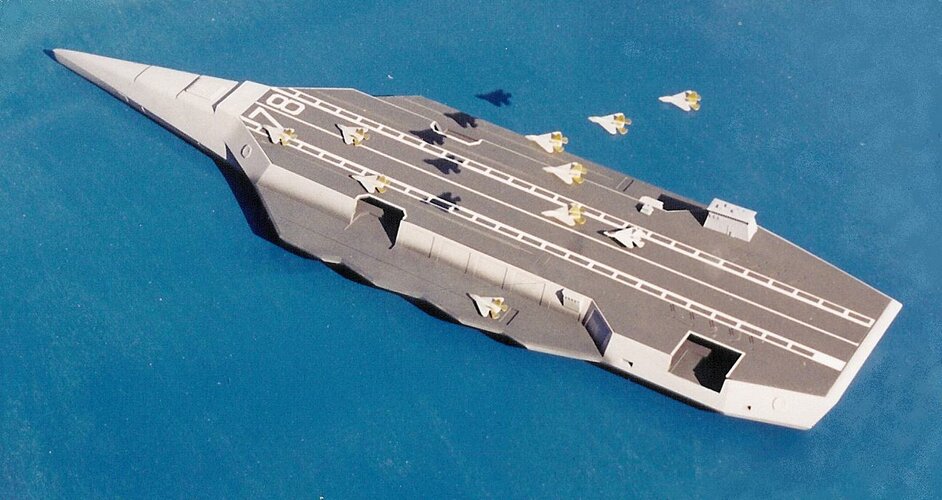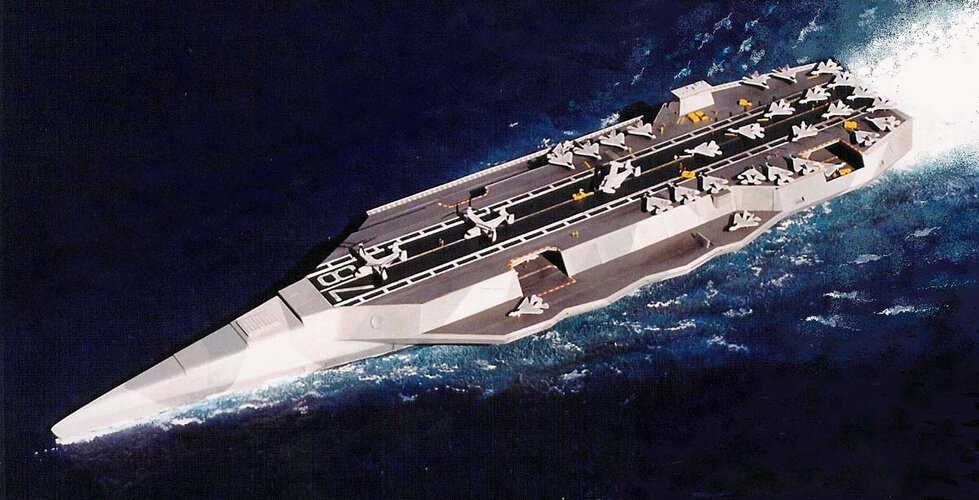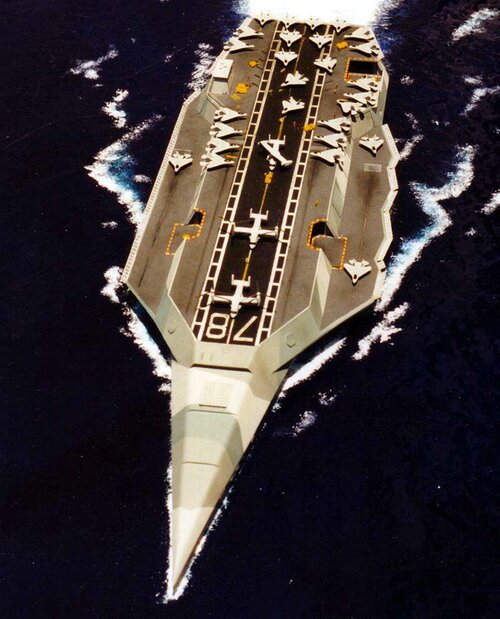If you went multihull then trimaran makes sense with semi-submerged tumblehome outriggers as stabilizers and a more conventional central hull, with all three ultimately having similar volume displacements below the waterline. The outriggers can support launch decks, accessible from a false deck accessed straight out from the hanger deck. Flights returning should have neglible impact on launch operations. Rely on JPALS for precise landings. During high sea states you seal off the accesses to the lower launch platforms and scale back to conventional operations. Instead of aiming for 60-70 aircraft, aim for a more utility purpose with around a dozen tops. You do not need shrunk down CVNs, but rather ships that operate as forward reaction cruisers to clamp down on bad actors in a theater long enough for a larger task group to arrive. Knowing someone can throw F-35C at you around the clock is pretty signifigant, more so than most any carriers below a CVN. With CVNs going to $20 billion apiece, its time to see what 4-5 gets you.
You are using an out of date browser. It may not display this or other websites correctly.
You should upgrade or use an alternative browser.
You should upgrade or use an alternative browser.
What might the aircraft carriers of the future look like ?
- Thread starter F.L.
- Start date
- Joined
- 6 November 2010
- Messages
- 5,267
- Reaction score
- 5,527
The 382m length, 124m beam, 932,000 tonnes max displacement crane-vessel Pioneering Spirit is a catamaran. At 14 kts max, it's sloooow.- Multihulls just plain haven't been tried at the sizes aircraft carriers reach, which scuppers that idea until and unless someone actually builds a multihull ship that big.
F.L.
ACCESS: Top Secret
- Joined
- 27 September 2006
- Messages
- 6,421
- Reaction score
- 6,837
The number of nations operating full size catapult equipped carriers is very small (US, France and possibly China).
The UK and Russia could build (or convert QE/POW) new catapult carriers but not for a while.
Brazil, India, Italy, R of Korea, and Japan all have the ability to build/operate VSTOL carriers.
Argentina, Australia, Canada, and the Netherlands have operated carriers.
So in practice we are looking at either a Ford sized design or a Cavour type VSTOL ship.
The big ship at the moment is likely to be nuclear unless an alternative is developed.
An AEGIS successor might be fitted to US carriers along with PDMS (missile/gun or both or laser).
A new hull form would be quite a leap. The US LCS experience relevant here?
With the long lead in times to develop/build a new carrier design I am not sure how many of us on this site will see one. That said, China might surprise us.
The UK and Russia could build (or convert QE/POW) new catapult carriers but not for a while.
Brazil, India, Italy, R of Korea, and Japan all have the ability to build/operate VSTOL carriers.
Argentina, Australia, Canada, and the Netherlands have operated carriers.
So in practice we are looking at either a Ford sized design or a Cavour type VSTOL ship.
The big ship at the moment is likely to be nuclear unless an alternative is developed.
An AEGIS successor might be fitted to US carriers along with PDMS (missile/gun or both or laser).
A new hull form would be quite a leap. The US LCS experience relevant here?
With the long lead in times to develop/build a new carrier design I am not sure how many of us on this site will see one. That said, China might surprise us.
Scott Kenny
ACCESS: USAP
- Joined
- 15 May 2023
- Messages
- 11,737
- Reaction score
- 14,524
Those are a lot more reasonable that that subcarrier.Another design by the same artist. What's interesting is the presence of a VLS. And also the arrangement of the blast shields.
View attachment 710836View attachment 710837
Looks like ski jump carriers, not catapults. I think I would not have used 3x JBDs closely spaced like that, and actually deleted one. Have the longer run on the starboard side instead of centered, keep the shorter one where it is on the port side. And move VLS into the sponsons instead of aft of the island, which opens up more space for defensive missiles anyways. 4x16 Mk41 cells is basically as many SM2s and ESSMs as a Burke carries!
Then you can shove the island aft to make space for a flight deck arming area like the Fords have, and stick a SPY-6 Aegis rig on it.
Scott Kenny
ACCESS: USAP
- Joined
- 15 May 2023
- Messages
- 11,737
- Reaction score
- 14,524
I think we could make an argument for a 45kton ship being viable for the smaller navies. Basically a modern Midway (specifically USS Coral Sea due to the better flight deck angles), gas turbine electric IEP.The number of nations operating full size catapult equipped carriers is very small (US, France and possibly China).
The UK and Russia could build (or convert QE/POW) new catapult carriers but not for a while.
Brazil, India, Italy, R of Korea, and Japan all have the ability to build/operate VSTOL carriers.
Argentina, Australia, Canada, and the Netherlands have operated carriers.
So in practice we are looking at either a Ford sized design or a Cavour type VSTOL ship.
The QE class demonstrates that you can run a 75kton ship on gas turbines. Nuclear has its own set of complications.The big ship at the moment is likely to be nuclear unless an alternative is developed.
I don't think there's going to be a might about it. The wargames have made it clear that bunching up into mutually protective formations makes those formations DF21 bait.An AEGIS successor might be fitted to US carriers along with PDMS (missile/gun or both or laser).
So a carrier needs to be able to address ASBMs all by itself. Which basically means Aegis or successor equipment, plus at least 64x Mk41 cells. (A big carrier could simply replace the ESSM launchers with 16x Mk41 cells in the same footprint, and add a fourth set of cells)
Since China is building huge new drydocks like it's going out of style, they could surprise us with a trimaran carrier. That's the hull form I expect for the "next revolutionary carriers", some 1000ft long and 250ft abeam(!) judging by the LCS proportions (note that is actually not all that different from the flight deck size of a Ford-class, assuming that there's no overhanging sponsons). Trimarans are good for reducing how much power it takes to go through the water, and new ships are needing more and more power for everything but propulsion.A new hull form would be quite a leap. The US LCS experience relevant here?
With the long lead in times to develop/build a new carrier design I am not sure how many of us on this site will see one. That said, China might surprise us.
- Joined
- 27 September 2006
- Messages
- 6,421
- Reaction score
- 6,837
Agree on pretty much everything.
The Midway sized ship has always struck me as an orphan. Too big and expensive for the UK and France. CVV rejected by the USN in favour of more Nimitz.
I would have prefered the armed Cavour for the RN to the unarmed QE. We might even have afforded three (Ark Royal, Hermes and Eagle better names)
The Midway sized ship has always struck me as an orphan. Too big and expensive for the UK and France. CVV rejected by the USN in favour of more Nimitz.
I would have prefered the armed Cavour for the RN to the unarmed QE. We might even have afforded three (Ark Royal, Hermes and Eagle better names)
- Joined
- 29 November 2010
- Messages
- 1,783
- Reaction score
- 3,497
given the high costs of developing and deploying escort ships to protect a carrier
perhaps there's some countries that may consider a return to the heavily armed carrier concept like the Kiev class?
perhaps there's some countries that may consider a return to the heavily armed carrier concept like the Kiev class?
hagaricus
ACCESS: Barclaycard
- Joined
- 5 November 2010
- Messages
- 177
- Reaction score
- 172
Big holes in pressure hull, like the kind necessary to let airplanes come on deck, make submariners clench so hard they can make diamonds. Read up on the Regulus missile subs from the late 1950s and early 1960s.
Hence vertical hangarage, aircraft with folded wings treated like missiles in tubes.
A Tentative Fleet Plan
I really should change my personal text
- Joined
- 9 April 2018
- Messages
- 1,213
- Reaction score
- 2,836
The US Navy could build carriers with up to 1080ft of waterline length, bigger than Enterprise or Nimitz, and looked at conventional carriers along these lines in the 1960s, with one conventional design intended to match ship endurance with airwing endurance being 1300ft long, although this was less capable than an Enterprise-sized nuclear carrier carrying the same amount of ordnance, 2/3rds as much fuel and worse endurance. Still conventional carriers make sense if you want to limit costs, Medium and Great Powers can basically go as large as they want when it comes to carriers, provided they don't add a bunch of costs by going for nuclear power. Superpowers like the US and China can afford nuclear power, I expect they will continue to build CVNs for the next few decades of this century.
Carrier size is dictated by a variety of factors, Flight Deck area, Hangar volume, volume in the hull for ordnance and fuel, seakeeping etc, and none of them point to small carriers being better.
I might add that of all surface combatants, aircraft carriers (and amphibious warships) are probably the best places to take advantage of any revolution unmanned aircraft. Where better to put unmanned aircraft than on the ships that already have significant volume required for the operation of manned aircraft?
Carrier size is dictated by a variety of factors, Flight Deck area, Hangar volume, volume in the hull for ordnance and fuel, seakeeping etc, and none of them point to small carriers being better.
I might add that of all surface combatants, aircraft carriers (and amphibious warships) are probably the best places to take advantage of any revolution unmanned aircraft. Where better to put unmanned aircraft than on the ships that already have significant volume required for the operation of manned aircraft?
If the US had more money in the 1960s, then all CVAs and CVANs would have Terrier or Tartar, and SQS-23 Sonars. There were proposals for designs with Typhon during the design process of the John F. Kennedy, and fitting carriers with SPY-1 has been proposed, if only for a Naval Engineers Journal article. Given the dispersed formations that were already adopted in the face of nuclear weapons, one wonders why there weren't more attempts to improve Aircraft Carrier survivability.I don't think there's going to be a might about it. The wargames have made it clear that bunching up into mutually protective formations makes those formations DF21 bait.
So a carrier needs to be able to address ASBMs all by itself. Which basically means Aegis or successor equipment, plus at least 64x Mk41 cells. (A big carrier could simply replace the ESSM launchers with 16x Mk41 cells in the same footprint, and add a fourth set of cells)
Last edited:
F.L.
ACCESS: Top Secret
Nice design of light carrier/amphibious assault ship derived from America-class.


 www.thedrive.com
www.thedrive.com
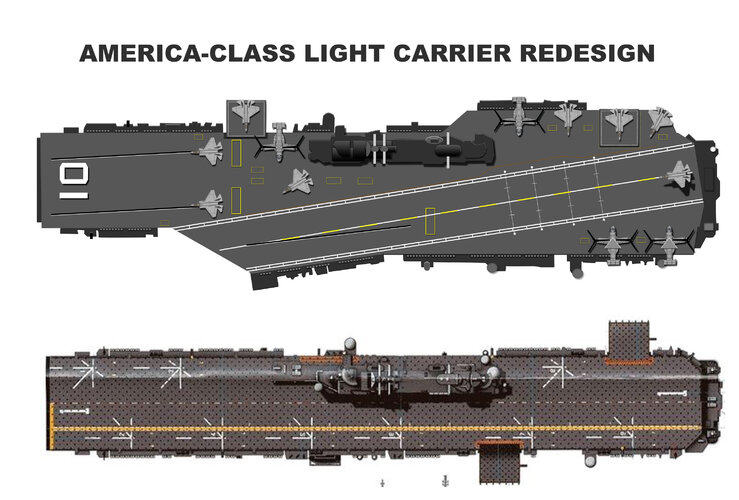

Senators Are Finally Funding A Design Study For A New Light Aircraft Carrier
Could this be the beginning of the end for the Navy's decades old all nuclear supercarrier procurement strategy?
Attachments
Last edited:
A Tentative Fleet Plan
I really should change my personal text
- Joined
- 9 April 2018
- Messages
- 1,213
- Reaction score
- 2,836
Too slow, limited to 20knots, and insufficient fuel and ordnance stowage.Nice design of light carrier/amphibious assault ship:
View attachment 710842

Senators Are Finally Funding A Design Study For A New Light Aircraft Carrier
Could this be the beginning of the end for the Navy's decades old all nuclear supercarrier procurement strategy?www.thedrive.com
Internal schematics of the LHA-6/7 design v LHA-8. Note the limited hangar, workshop and stores area and the limited “high hat” areas for aircraft maintenance.
 www.globalsecurity.org
www.globalsecurity.org
LHA 6 Flight I / LHA 8 class - Schematic
The LHA(R) was intended to replace the LHA 1 Class amphibious assault ships and would provide forward presence and power projection as an integral part of joint, interagency and multinational maritime expeditionary forces. The LHA(R) Flight 0 Ship would be a variant of the LHD 8 amphibious...
- Joined
- 29 November 2010
- Messages
- 1,783
- Reaction score
- 3,497
based on the articles above..
what the USN wants as a "light carrier" isn't something like those STOVL carriers
but basically a Queen Elizabeth class in CATOBAR, which to most people, is not light.
that said, for ships under 40,000 tons.. the Cavour is my favorite STOVL carrier.
what the USN wants as a "light carrier" isn't something like those STOVL carriers
but basically a Queen Elizabeth class in CATOBAR, which to most people, is not light.
that said, for ships under 40,000 tons.. the Cavour is my favorite STOVL carrier.
Just need to fix the narrow hangar width.for ships under 40,000 tons.. the Cavour is my favorite STOVL carrier.
(My understanding is Cavour has aviation workshops & troop accommodation along the left side of the hangar, which could be eliminated and/or moved elsewhere. The hangar is also very high - 3 decks - and could be reduced to 2 decks in some places to allow for more accommodation in the gallery deck above it)
Also ideally go with a smaller island or 2 islands as on Trieste, which requires downsizing the propulsion to CODAG (2 gas turbines + diesels) vs COGAG (4 gas turbines), thereby simplifying the intake/uptake arrangement. For example, going to a Chakri Naruebet sized island would save 90ft of deck space and allow for 3 more aircraft parking spots on deck.
Last edited:
For UUVs (Underwater Unmanned Vehicles) could the submarine carrier ideas being floated (pun unintended) be used? I guess this wouldn't be an aircraft carrier, but it seems related enough to the drone carriers being discussed. I just watched a video on tail sitting and other VTOL drones, perhaps they could be launched like VLS. Could a vertical catapult be made perhaps? Here is an idea I mocked up. It pulls the aircraft straight up at first then to the side a bit.

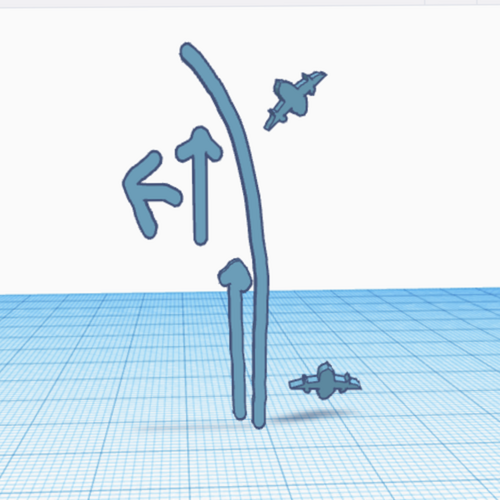
Sorry about the massive image, I couldn't figure out how to scale it down, or get the text where I wanted it. I was wondering if fixed wing aircraft would need assistance in the turn to horizontal flight when launched from a vertical catapult. In essence this is a normal one but rotated 90 degrees the flipped around the y-axis.
FYI, here’s an old take I did on an aviation optimized Cavour.for ships under 40,000 tons.. the Cavour is my favorite STOVL carrier.

F.L.
ACCESS: Top Secret
Not conversion, but redesign. Probably improved speed & ordonnance storage.Too slow, limited to 20knots, and insufficient fuel and ordnance stowage.
I think an amphibious assault ship/aircraft carrier hybrid would be interesting.
Colonial-Marine
UAVs are now friend, drones are the real enemy.
- Joined
- 5 October 2009
- Messages
- 1,477
- Reaction score
- 1,336
While I wouldn't mind seeing a somewhat heavier defensive armament for our CVNs I have my doubts trying to incorporate the missile armament of a full guided missile cruiser or destroyer is the best direction. If the Chinese are able to detect a carrier alone or almost alone they will still not hesitate to launch a DF-21 at it. Going without all of the escorts means a greater risk from submarines or a massed attack from aircraft with AShMs.I don't think there's going to be a might about it. The wargames have made it clear that bunching up into mutually protective formations makes those formations DF21 bait.
F.L.
ACCESS: Top Secret
SSgtC
ACCESS: Top Secret
- Joined
- 13 July 2020
- Messages
- 1,241
- Reaction score
- 2,896
That's a lot harder than it sounds. Hull form has an enormous effect on speed. And given you're restricted to the current hull form, you would probably need to triple the avaliable SHP just to get the ship up from 20 knots to 27ish.Not conversion, but redesign. Probably improved speed & ordonnance storage.
I think an amphibious assault ship/aircraft carrier hybrid would be interesting.
A Tentative Fleet Plan
I really should change my personal text
- Joined
- 9 April 2018
- Messages
- 1,213
- Reaction score
- 2,836
The most expensive bit of a DDG are going to be the radars. To ensure that the carrier does not have unique radars with distinct frequencies that can identify by passive means (the Soviets put significant effort not just into tracking Carrier Battle Groups, but also into finding out the carrier's exact position in the formation), the carrier will have to use the same radars as the rest of the fleet (this is why the US standardised on the SPS-48 and -49 during the Cold War, and appears to be standardising on SPY-6 now) when it (rarely) actively emits. As such this means that the carrier will have similar radars to the DDG, it may well be a good idea to have some means of taking advantage of said radar's capabilities.While I wouldn't mind seeing a somewhat heavier defensive armament for our CVNs I have my doubts trying to incorporate the missile armament of a full guided missile cruiser or destroyer is the best direction. If the Chinese are able to detect a carrier alone or almost alone they will still not hesitate to launch a DF-21 at it. Going without all of the escorts means a greater risk from submarines or a massed attack from aircraft with AShMs.
Given the increasingly dispersed nature of modern naval combat, the carrier will also beany miles away from its escorts. Giving it some short range point defence capability may be useful, and potentially in addition some all-weather stand-off ASW capability. Dropping a lightweight torpedo on an enemy submarine will force them to evade and break the wires of any torpedoes they have fired at the carrier, making evasion easier.
CV12Hornet
ACCESS: Top Secret
- Joined
- 8 January 2021
- Messages
- 512
- Reaction score
- 1,171
Er, CVNs don't go for $20 billion apiece. The latest buys have been around $11 billion.Instead of aiming for 60-70 aircraft, aim for a more utility purpose with around a dozen tops. You do not need shrunk down CVNs, but rather ships that operate as forward reaction cruisers to clamp down on bad actors in a theater long enough for a larger task group to arrive. Knowing someone can throw F-35C at you around the clock is pretty signifigant, more so than most any carriers below a CVN. With CVNs going to $20 billion apiece, its time to see what 4-5 gets you.
Also, if you're paying $4-5 billion for a light carrier carrying only 12 aircraft you're way overpaying somewhere. That's closer to the cost of a QE and quite a bit higher than an America.
Not gonna lie, I'd forgotten about her. But yes, she's very slow; between that and her semi-submersible operation I have my doubts she's a good comp for a multihull carrier.The 382m length, 124m beam, 932,000 tonnes max displacement crane-vessel Pioneering Spirit is a catamaran. At 14 kts max, it's sloooow.
- Joined
- 3 June 2011
- Messages
- 18,369
- Reaction score
- 12,326
No-one seems to think they'll be submarines? They're already huge & nuclear powered, launching missiles from silos. Launching UAVs either underwater or surfaced from silos or deck isn't too much of a stretch.
My fantasy of adding an offset conning tower, deck runway with retractable ski jump and arrestor wires, and vertical hangarage for tailsitters may well be, but I'd be happy for anyone to tell me just why such an idea is preposterous.
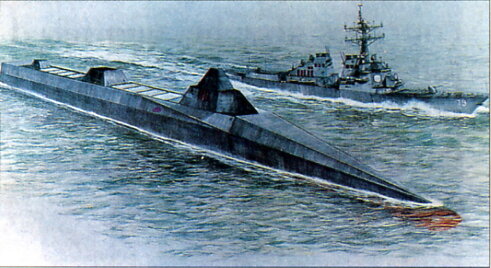
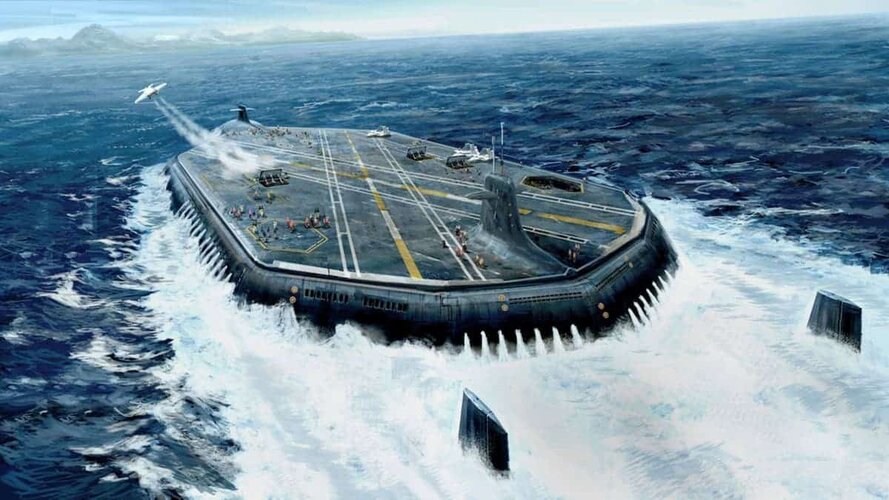
Scott Kenny
ACCESS: USAP
- Joined
- 15 May 2023
- Messages
- 11,737
- Reaction score
- 14,524
No space to do maintenance, and aircraft engines don't like being stored vertically. Their lube systems really throw a fit. Hence why the V280's engines don't rotate, even though they're the same engines as on an Osprey.Hence vertical hangarage, aircraft with folded wings treated like missiles in tubes.
The Regulus SSGs had horizontal tubes laid on the deck and faired in.
The closest anyone really came was the Ohio SSGNs with LockMart Cormorant drones, and I don't think they were intended to be rearmed or refueled on the subs based on how they folded the wings around the fuselage to fit into the tube.
Not counting the Tuatha de Danaan from Full Metal Panic, which in the books is a converted Typhoon, and in the anime has the flight deck where most of the missile tubes used to be. But it still has a HUGE door for the aircraft to go through. That said, the EM weapons elevator design might be modifiable to work, the trick is going to be doubling the doors to provide proper SUBSAFE sealing.
The space is physically there already, and the SPY-6 radar to run it is getting installed. You can drop 16x Mk41 cells into the footprint of an ESSM launcher, and carriers have 3x ESSMs installed. That'd be 48x Mk41 cells, enough space for 32x SM2, 32x ESSM in 8x quadpacks, and 8x SM6 if you think a carrier needs that many. If you can add or find enough space for 16x more cells (Fords have that big space on the aft port corner), you have the same defensive missile capacity as a DDG.While I wouldn't mind seeing a somewhat heavier defensive armament for our CVNs I have my doubts trying to incorporate the missile armament of a full guided missile cruiser or destroyer is the best direction.
Then it'd be good for the carrier itself to be able to engage DF-21s, wouldn't it? Again, space and radar is already there on the carriers.If the Chinese are able to detect a carrier alone or almost alone they will still not hesitate to launch a DF-21 at it.
Yes, that's a known risk. I'm not sure if the wargames included putting one ASW escort with the carrier while spreading everyone else around. I believe that the point was to spread out enough that any given ship would only be under threat from directly aimed DF-21s, not being within terminal guidance range of an entire salvo. Say that the DF-21's seeker has a ~50nmi field of view when it selects targets, though I suspect the actual number is a lot bigger. This means that the carrier group needs to spread out so that no ship is within 30nmi of another.Going without all of the escorts means a greater risk from submarines or a massed attack from aircraft with AShMs.
Adding ASW capabilities to a carrier like a hull sonar is a much bigger cost increase, as they'd have to redesign the clown nose OR figure out how to stuff the sonar into the existing clown nose. Much easier to add an ASW escort to each ship in the carrier group.
Last edited:
Scott Kenny
ACCESS: USAP
- Joined
- 15 May 2023
- Messages
- 11,737
- Reaction score
- 14,524
Costs, I'm assuming. There was a really bad case of sticker shock over the Enterprise, hence why the JFK was conventional.If the US had more money in the 1960s, then all CVAs and CVANs would have Terrier or Tartar, and SQS-23 Sonars. There were proposals for designs with Typhon during the design process of the John F. Kennedy, and fitting carriers with SPY-1 has been proposed, if only for a Naval Engineers Journal article. Given the dispersed formations that were already adopted in the face of nuclear weapons, one wonders why there weren't more attempts to improve Aircraft Carrier survivability.
F.L.
ACCESS: Top Secret
This imaginary design is pretty cool.
 www.dedoimedo.com
www.dedoimedo.com

Submarine + aircraft carrier - Wicked!
3D art gallery - Large, twin-hulled nuclear-powered hybrid aircraft carrier and submarine with a retractable flight deck, ballistic missiles and air defense weapons, somewhat reminiscent of the Russian Typhoon class and inspired by the WWII Imperial Japanese Navy designs, designed in Google...
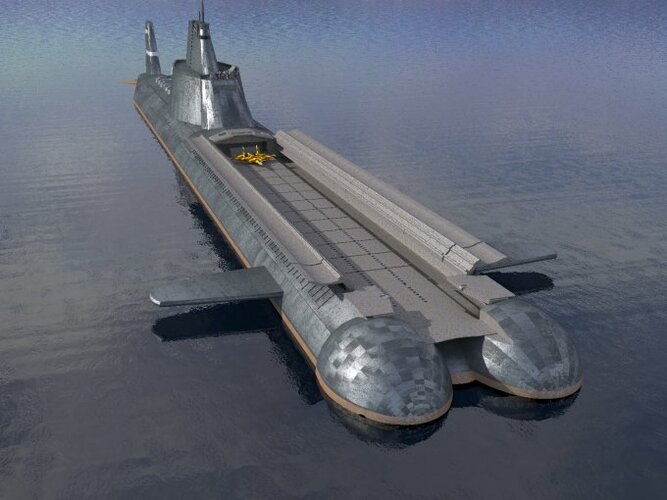
Last edited:
F.L.
ACCESS: Top Secret
Scott Kenny
ACCESS: USAP
- Joined
- 15 May 2023
- Messages
- 11,737
- Reaction score
- 14,524
That was one of the stealthier carrier concepts, right?
I gotta admit, I'm not sold on the wave-piercing bow for a carrier, nor am I sold on the flight deck layout. That lost a whole lot of deck area, even if the landing strip is the same length as on a Nimitz. Those low side cats are likely to be very wet and not usable in anything resembling normal seas.
- Joined
- 29 November 2010
- Messages
- 1,783
- Reaction score
- 3,497
to be honest, half of these designs would probably feel at home in Ace Combat than the real world
Kat Tsun
eeeeeeeeeeeeeee
- Joined
- 16 June 2013
- Messages
- 1,381
- Reaction score
- 1,794
The premiere carrier operator on the planet, the USN, studied all of these options during the Ford design process and went back to the monohull.
More because they couldn't do literally anything other than a Nimitz hull. I'm not even sure if the starboard list was corrected.
Actually new ships require actually new dockyards, and investment in infrastructure that never happened, or were never sustained. This is a common American problem, but not a European problem, which is why the British were able to make a carrier with actual 1990's-era improvements. It's also why the Europeans, despite buying TDPs for American warships in the 1990's, were actually able to make these ships.
Meanwhile the USN is struggling to keep producing 1980's ships with 1970's shipyards in the 2020's. It's pretty bad.
Why do you think the Constellations are a imported design? The USN sort of let its capacity to create new ships die with the DDGX and LCS.
That was one of the stealthier carrier concepts, right?
I gotta admit, I'm not sold on the wave-piercing bow for a carrier, nor am I sold on the flight deck layout. That lost a whole lot of deck area, even if the landing strip is the same length as on a Nimitz. Those low side cats are likely to be very wet and not usable in anything resembling normal seas.
You don't have a "deck area" with this ship. That's what the hangar is for. The side cats would be fine, they had protective walls that erect.
It was designed as a thought experiment, though, rather than an actual producible design. For one thing, it had Aegis and 64 VLS cells. I suspect most designs of the CVN21 were attempts to make as silly a concept as possible, to make the amalgamated combinations of technology inserted Nimitzes look more practical, rather than seriously studying the problem of carrier design in the 21st century.
The Navy just happened to find one of the rarest creatures in its stable, a serious professional, who was able to put it together.
Too slow, limited to 20knots, and insufficient fuel and ordnance stowage.
Could just as easily be said for the Fords and Nimitzes, if we're talking about survivability, which is the real issue carriers face:

The U.S. Fleet Could Lose Four Aircraft Carriers Defending Taiwan
Even when the United States and Japan successfully defended Taiwan—as they did in most of one think-tank’s 24 simulations—the U.S. Navy lost at least two carriers ... and sometimes as many as four.
 www.forbes.com
www.forbes.com
Midway isn't quite right, but CVF isn't too far off anyway, perhaps Kitty Hawk is a better comparison point. Give it 20 to 40 A-12-type attack aircraft with combat radii in the 1,000-1,500 nmi range and it might be able to do something useful.
Nimitzes being sized for Vietnam type conventional munition expenditure, in an era where even the most basic aviation bomb is a satellite guided weapon, is a bit silly. Ordnance storage can probably be reduced by nearly an order of magnitude without significantly reducing the ability of the carrier to fight for the initial 48-72 hours, provided there's a commensurate reduction in air wing size. The latter has already occurred with the Super Hornet and Lightning air wings.
CVF does a lot of things right in this regard. The Nimitz only really makes sense if you have a massive air wing (90+ aircraft), emphasize alpha strikes, and hit targets with CCIP and sticks of iron bombs. Otherwise, it's an inefficient design.
Last edited:
Scott Kenny
ACCESS: USAP
- Joined
- 15 May 2023
- Messages
- 11,737
- Reaction score
- 14,524
I fully expect the later Fords to have 16x VLS cells in place of each Sea Sparrow launcher, set at about a 5-10 degree outboard angle. That's 48 (3x16) cells without trying, and if you can find space for another 16 cells you have the same capacity as a Burke's SAM loadout. Hint: the Fords have a huge space on their port aft quarter. Nimitz class is a bit tougher to decide on, I think I'd look at starboard forward quarter and set those cells in line instead of in a square.You don't have a "deck area" with this ship. That's what the hangar is for. The side cats would be fine, they had protective walls that erect.
It was designed as a thought experiment, though, rather than an actual producible design. For one thing, it had Aegis and 64 VLS cells. I suspect most designs of the CVN21 were attempts to make as silly a concept as possible, to make the amalgamated combinations of technology inserted Nimitzes look more practical, rather than seriously studying the problem of carrier design in the 21st century.
And all the carriers are getting fitted with SPY6, so we might as well fit Aegis to take advantage of the capabilities of the radar.
Refit the Nimitz carriers with VLS cells as well, and refit the PACFLT carriers first.
Kat Tsun
eeeeeeeeeeeeeee
- Joined
- 16 June 2013
- Messages
- 1,381
- Reaction score
- 1,794
I fully expect the later Fords to have 16x VLS cells in place of each Sea Sparrow launcher, set at about a 5-10 degree outboard angle.
I wouldn't expect any Fords to receive major upgrades tbh.
The USN will probably lose at least one, maybe two or more, in the next Pacific War. It will then have enough trouble over the latter half of the 21st century maintaining the 7 or 8 or so carriers it might end up coming out of the war, at worst, so much so that talking about replacement is a bit fanciful.
It will be down to 5 carriers in the 2040's in the worst case scenario, which is the one where it loses four CVNs but beats the PLAN.
Take CSIS wargames with a bit of salt but the idea of losing carriers is almost anathema to US Navy planners. Whether it's better to show their obsolescence by being sunk, or simply not participating meaningfully during the war, is an open question. The funny part is it has almost nothing to do with the carriers and everything to do with the fact that the USN doesn't take naval aviation seriously.
That's 48 (3x16) cells without trying, and if you can find space for another 16 cells you have the same capacity as a Burke's SAM loadout. Hint: the Fords have a huge space on their port aft quarter. Nimitz class is a bit tougher to decide on, I think I'd look at starboard forward quarter and set those cells in line instead of in a square.
None of them are getting armaments on that scale, not only can the USN not afford it, it isn't reasonable to expect a CVN to pack VLS.
And all the carriers are getting fitted with SPY6, so we might as well fit Aegis to take advantage of the capabilities of the radar.
Refit the Nimitz carriers with VLS cells as well, and refit the PACFLT carriers first.
EASR is just a VSR and traffic control radar, though.
The Nimitzes are so old, and shipyard space so limited, that mere maintenance consumes all available docks too. It won't happen. Smaller carriers, possibly inspired by CVF or something, are likely inevitable simply to allow production in more yards. No one is going to be getting nuclear carrier certification outside of HII, but nuclear carriers could rapidly be abandoned in favor of conventional ones. Again.
Not sure what yards might be able to build a Kitty Hawk, though, but I imagine there might be one or two more that could do it.
It has neither the capacities to produce sufficient supercarriers, nor do much more than basic maintenance, and the supercarriers do not have the air wings to reasonably be expected to contribute to the joint fight. Much like the entire U.S. Army, the Navy's carrier fleet will be sitting on its butt doing essentially nothing, while the Air Force bombers and submarine fleet do all the actual work. That's if they don't get caught with their pants down during a transit or something.
Future carriers will be smaller just so shipyards that can produce gators can make attack carriers too. That might necessitate a reversion to Midway by fiat, because Midway isn't much different in size to an LHA-6, but there's a lot more surplus capacity to build LPDs and LHAs than CVNs. A token supercarrier force, supplemented by 50-80,000 ton CVV/CVA, seems most likely.
It's the only way to maintain double digit carrier numbers into the latter half of the century. Doubly so if the Chinese sink some CVNs.
The absolute worst case for the carrier force would be someone sees their abysmal performance with the Super Hornet, says carriers are bad, and decides to invest in submarines and heavy twinjet bomber wings for the USN to turn it into the Soviet Navy. That's also possible, but way less likely, if only because naval aviation would lose its mind and because I don't think any USN arm is going to perform particularly well in a second Pacific War anyway.
Last edited:
Scott Kenny
ACCESS: USAP
- Joined
- 15 May 2023
- Messages
- 11,737
- Reaction score
- 14,524
Why not? It's literally sitting in the same spot as the ESSM launchers on that arc, and my version is expressly angled outboard so that boosters can't drop onto the deck park.None of them are getting armaments on that scale, not only can the USN not afford it, it isn't reasonable to expect a CVN to pack VLS.
Every other carrier that isn't US has VLS defensive missiles.
We're not sticking a bunch of freaking Tomahawks on a carrier, we're putting SM2Actives, ESSMs, and maybe some SM6s in. Or the odd SM3s if those are better for dealing with DF-21s.
Without aegis it is.EASR is just a VSR and traffic control radar, though.
But it's also the same physical hardware as the SPY6 on Flight 3 Burkes, so why NOT install aegis to take advantage of the capabilities? How expensive is the aegis FCS?
Kat Tsun
eeeeeeeeeeeeeee
- Joined
- 16 June 2013
- Messages
- 1,381
- Reaction score
- 1,794
Why not?
Because all the drydocks are taken up with very basic maintenance? There's literally no room, nor scheduled time, available.
It's literally sitting in the same spot as the ESSM launchers on that arc, and my version is expressly angled outboard so that boosters can't drop onto the deck park.
Every other carrier that isn't US has VLS defensive missiles.
CVF doesn't, and it's the only good one that isn't American, so why would U.S. carriers bother?
We're not sticking a bunch of freaking Tomahawks on a carrier,
This would be smarter, because it would give them actual reach in their strike radii, tbf.
we're putting SM2Actives, ESSMs, and maybe some SM6s in. Or the odd SM3s if those are better for dealing with DF-21s.
SM6s, with a production rate of "dozens" a year, can afford to be mounted on a carrier?
Without aegis it is.
I'm pretty sure the Fords use a derivative of the Aegis Combat System, like the LCS ships, but it's neither here nor there.
But it's also the same physical hardware as the SPY6 on Flight 3 Burkes, so why NOT install aegis to take advantage of the capabilities?
Because there's literally no money to buy the missiles to arm them, no time to refit the missiles into place, and no engineering capacity to figure out how to install them in the first place.
How expensive is the aegis FCS?
It's about the USN lacking the fundamental capacities to do basic things. All it can do these days is sail around and crash into stuff.
It might also be able to win a war, against a very unprepared and under experienced opponent, but only by the skin of its teeth. Because it's a hollowed-out organization that destroyed itself 40 years ago, to increase the head count of operational commanders to accommodate a pie-in-the-sky 600-ship navy, and now it has to pay the price for that.
This is what happens when you rapidly build up a navy and then decide you don't want to sustain that level of spending anymore: the navy breaks. Given how the Cold War turned out, perhaps the 600-ship navy was a mistake after all, but no one could have foreseen that.
The practical solution is simply scaling back to Zumwalt and Carter's ideas to maintain a basic, modestly credible 300-ship navy. That boat sailed on that during the Global War on Terror, when the Navy's money was eaten by the overseas contingency funds and Iraq and a bunch of failed and useless experimental ships like DDGX and LCS, but there's always the next half of the century to plan for.
A bigger Burke, paring down the Ford buys to 6 or 8 CVNs (depends on the timing, they'll need about three to four years to engineer the new ship and begin bending steel), and a 1.25:1 ratio of Kitty Hawk or Midway-sized CVAs instead, would let the USN keep its 11 or 12 carrier fleet without unduly impacting combat performance in small wars. Which is about all a F-35C equipped carrier force can do. Ideally it'd be something like 6 CVNs and 8 CVAs, but that won't happen, or else it would have happened by now.

Light Carrier Studies Already Underway As Navy Considers Role for CVLs in Future Fleet - USNI News
The Navy’s engineering community has already started conducting light carrier design and engineering studies, even as the Navy and the joint force still consider whether they’d even want to invest in a CVL to supplement supercarriers to bring more distributed capability to the fleet for less...
A Midway-size ship is eminently buildable in more yards than Newport News, while a Kitty Hawk might require investment in Pascagoula, it would still be comparable to a Ford in practical combat capability.
Worst case scenario is the USN ends up with between 6 and 9 CVNs, and orders 3 or 4 more LHA-6 repeats, but even that's not terrible.
For the actually important, history-making wars that define human generations and culture for the next century, the Navy still has the submarines (at least until they start doing drugs like 7th Fleet does), and the Air Force just kind of exists, so it's not like the carriers are particularly important to begin with. They're for small wars now, and arguably always have been, since the first atom bomb detonated.
Last edited:
The artist impression in #70 leaves a lot to be desired. First off, the top deck is too symmetrical, and without the angled deck is an accident in the making as a jet comes in and has to magically land between rows of parked vehicles. I don't think you abandon the angled deck.
To me the tri-hull is much shorter than a Nimitz. While you retain the angled deck, you still want elevators, parking, and the bridge off to the right side. You could do a third elevator on the left as long as it doesn't disturb the visual landmarks for a pilot when JPALS is down, but to me its unecessary. I would want that angled deck every inch the same size as on a Nimitz, with the forward strip length chopped off. The angled deck would be floor level 2. The angled deck is multi-purpose, for recovery as its primary role and for launch space when necessary for mainly helicopters and possibly a backuo EMALS. The main deck, floor level 1, would extend out from the back to accommodate helicopter and other VL aircraft, in a 3x2 or 2x2 area that is unecumbered by the upper deck. Doors would allow aircraft on this rear ramp to enter the covered deck.
The coveres deck would be trident shaped, as there would be deck space that wraps around to extend over to rear deck pads over the outer hulls. The decks on the outer hulls would be shaped verically in an ogee curve. At the end of the curve would be a skijump. The curve of the ogee would swoop down to a point even with the internal hangar space, allowing for door access into the hangar. The doors would have to be strong enough for waves to hit them in a hurricane without compromising the hangar. The wraparound decks at the rear are covered by the angled deck above and are uncovered as they travel down the ogee deck, although some buttressing may extend over them. So the side decks may not be optimal for landing, as they would be purposed with takeoffs.
The rest of the main deck would extend forward from the rear doors out the front of the ship. Walls would run down the lengths of each side, but they would have sliding portals to prevent the area being completely interiorized. But when necessary, such as in high winds, I think its important that this space can be possible to secure as encapsulated. The main deck would be mostly focused on launching and loading/unloading aircraft. While the covered space would be fine for protection from weather, it also has to be able to survive mishaps with ordnance. The ability to open and close off the main deck area is just as important as being able to isolate problems such as fires, out of control automated carts, or rolling bombs. And because jets would be running full blast at takeoffs, its important to control that stream of hot, high pressure air, too. And your EMALS needs to breathe to cool down, so there is that. Should be able to run your EMALS in a 4-wide arrangement. Its important that aircraft leaving from the six main areas not interfere with each other. And your angled deck should have minimal impact on launching operations. And your heli and VL traffic should inegrate in with the other traffic seamlessly.
I also like the idea of dock space on these ships. You should be able to use light boats out the aft spaces of the hulls. You should also be able to offload directly on to main deck space or the lower ogee space. It might even be smart to have a smaller elevator/dumbwaiter for pallets that runs to internal space accessible from the decks.
A light version using two hulls could reduce to only two EMALS on the main deck, one ogee on the left side, and a smaller rear space for helicopters.
To me the tri-hull is much shorter than a Nimitz. While you retain the angled deck, you still want elevators, parking, and the bridge off to the right side. You could do a third elevator on the left as long as it doesn't disturb the visual landmarks for a pilot when JPALS is down, but to me its unecessary. I would want that angled deck every inch the same size as on a Nimitz, with the forward strip length chopped off. The angled deck would be floor level 2. The angled deck is multi-purpose, for recovery as its primary role and for launch space when necessary for mainly helicopters and possibly a backuo EMALS. The main deck, floor level 1, would extend out from the back to accommodate helicopter and other VL aircraft, in a 3x2 or 2x2 area that is unecumbered by the upper deck. Doors would allow aircraft on this rear ramp to enter the covered deck.
The coveres deck would be trident shaped, as there would be deck space that wraps around to extend over to rear deck pads over the outer hulls. The decks on the outer hulls would be shaped verically in an ogee curve. At the end of the curve would be a skijump. The curve of the ogee would swoop down to a point even with the internal hangar space, allowing for door access into the hangar. The doors would have to be strong enough for waves to hit them in a hurricane without compromising the hangar. The wraparound decks at the rear are covered by the angled deck above and are uncovered as they travel down the ogee deck, although some buttressing may extend over them. So the side decks may not be optimal for landing, as they would be purposed with takeoffs.
The rest of the main deck would extend forward from the rear doors out the front of the ship. Walls would run down the lengths of each side, but they would have sliding portals to prevent the area being completely interiorized. But when necessary, such as in high winds, I think its important that this space can be possible to secure as encapsulated. The main deck would be mostly focused on launching and loading/unloading aircraft. While the covered space would be fine for protection from weather, it also has to be able to survive mishaps with ordnance. The ability to open and close off the main deck area is just as important as being able to isolate problems such as fires, out of control automated carts, or rolling bombs. And because jets would be running full blast at takeoffs, its important to control that stream of hot, high pressure air, too. And your EMALS needs to breathe to cool down, so there is that. Should be able to run your EMALS in a 4-wide arrangement. Its important that aircraft leaving from the six main areas not interfere with each other. And your angled deck should have minimal impact on launching operations. And your heli and VL traffic should inegrate in with the other traffic seamlessly.
I also like the idea of dock space on these ships. You should be able to use light boats out the aft spaces of the hulls. You should also be able to offload directly on to main deck space or the lower ogee space. It might even be smart to have a smaller elevator/dumbwaiter for pallets that runs to internal space accessible from the decks.
A light version using two hulls could reduce to only two EMALS on the main deck, one ogee on the left side, and a smaller rear space for helicopters.
carvalho2008
Naval alternative projects
- Joined
- 20 November 2015
- Messages
- 452
- Reaction score
- 500
One thing that many people confuse is the type of question and the type of appropriate response to it. This is a theme that always returns, but the personal impressions of even technicians and professionals sometimes invade the initial logic. At least for me, the aircraft carrier has no other function than to guarantee naval air power to its fleet, whether to defend or attack an objective. The center is the naval fixed wing and how it can secure its objectives. Most of the time, the debate gets distorted trying to compare whether a Super carrier is better than a smaller ship. This is discussing the obvious, of course a supercarrier alone is better than any ship in its smaller tonnage category!! This is obvious...!!! As much as cost optimization through savings in redundant crews and concentration also makes it possible. The problem is how much you need to have in a global or localized conflict scenario. Well, in a localized conflict the answer is already given, 1 or 11 units are enough....but in a global conflict...no!!! not enough!! And the type of solution does not allow having 20 or 30 of them!!!
I don't really think it's useful to discuss whether plane "a" is better than "b", but rather whether the strategy of the set of "a" is better or worse than "b". This is indeed productive, as the answers have already been given whenever the pragmatism of reality knocking on our door presents itself. At the end of WWII, the USA had more than 70 aircraft carriers of different categories....it is the same as discussing whether the USA should, at the time, have built only Essex Class units, regardless of urgency, time, resources and missions. If this was really necessary, why would today be any different? And if the most powerful country with the best doctrines will be charged on this point, why wouldn't smaller countries be the same? The question is how many navy planes will be flying attacking or defending their squadrons after 15 days of high-level attrition fighting? At this point, it is much safer if they can be diluted on several ships... as this way, the loss of some of them would still guarantee a high operational percentage of the remainder....

I don't really think it's useful to discuss whether plane "a" is better than "b", but rather whether the strategy of the set of "a" is better or worse than "b". This is indeed productive, as the answers have already been given whenever the pragmatism of reality knocking on our door presents itself. At the end of WWII, the USA had more than 70 aircraft carriers of different categories....it is the same as discussing whether the USA should, at the time, have built only Essex Class units, regardless of urgency, time, resources and missions. If this was really necessary, why would today be any different? And if the most powerful country with the best doctrines will be charged on this point, why wouldn't smaller countries be the same? The question is how many navy planes will be flying attacking or defending their squadrons after 15 days of high-level attrition fighting? At this point, it is much safer if they can be diluted on several ships... as this way, the loss of some of them would still guarantee a high operational percentage of the remainder....

Last edited:
- Joined
- 3 June 2011
- Messages
- 18,369
- Reaction score
- 12,326
That was actually a real design concept.The artist impression in #70 leaves a lot to be desired. First off, the top deck is too symmetrical, and without the angled deck is an accident in the making as a jet comes in and has to magically land between rows of parked vehicles. I don't think you abandon the angled deck.
Similar threads
-
Soviet carrier fighters 1950s-1960s
- Started by lancer21
- Replies: 24
-
-
-
Jean Bart battleship turned aircraft carrier (1942 - 1992)
- Started by Archibald
- Replies: 4
-


